Speech The Year Ahead
Thank you for the opportunity to address the National Press Club. It is an honour to have been invited.
The media and the RBA have a special relationship. Most people in the community hear the RBA's messages through the media. You report on what we say, you filter it and you critique it. We also help you with your work. The RBA is a reliable source of information and analysis on issues that your audiences care about, including interest rates, housing prices and jobs. This means we have a strong mutual interest in understanding one another. I hope that today will help strengthen that understanding.
This is my first public speech for 2019, so I would like to talk about the year ahead and some of the key issues that the RBA will be focusing on. I will first discuss the global economy and then turn to the Australian economy and particularly the outlook for household spending. I will finish with a few remarks on the outlook for monetary policy.
At the outset, I want to emphasise that we don't have a crystal ball that allows us to see the future with certainty. I know many of you are looking for definitive answers to questions like, ‘Where will the cash rate be this time next year?’, ‘How much will housing prices fall?’, ‘When will wages growth reach 3 per cent?’. They are all good questions. The reality, though, is that the future is uncertain. None of us can say with certainty what will happen.
What the RBA can do, though, is highlight the issues that are likely to shape the future, explain how we are thinking about those issues, and discuss how they fit into our decision-making framework. That is what I hope to do today.
The Global Economy
I will start with the global economy, because what happens overseas has a major bearing on what happens in Australia. My main point here is that while some of the downside risks have increased, the central scenario for the world economy still looks to be supportive of growth in Australia.
It is worth recalling that 2018 was a good year for the world economy. Growth in the advanced economies was above trend in the first half of the year, unemployment rates reached their lowest levels in many decades, inflation was low and financial systems were stable (Graph 1). These are positive outcomes. We should not lose sight of this.
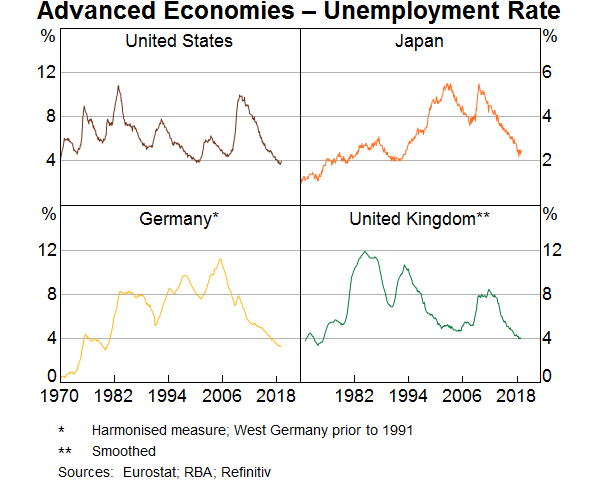
There was, though, a change in momentum in the global economy late in the year. This change was particularly evident in Europe and it was also evident in China. It has been widely reported in the media, but it is important to keep things in perspective.
Some slowing in global growth was expected, given that labour markets are fairly tight and the policy tightening in the United States was aimed at achieving a more sustainable growth rate. So, I have been a little surprised at some of the reaction to the lowering of forecasts for global growth, which has been quite negative. We need to remember that the IMF's central forecast is still for the global economy to expand by 3.5 per cent in 2019 and by 3.6 per cent in 2020 (Graph 2). If achieved, these would be reasonable outcomes and not too different from the recent past.
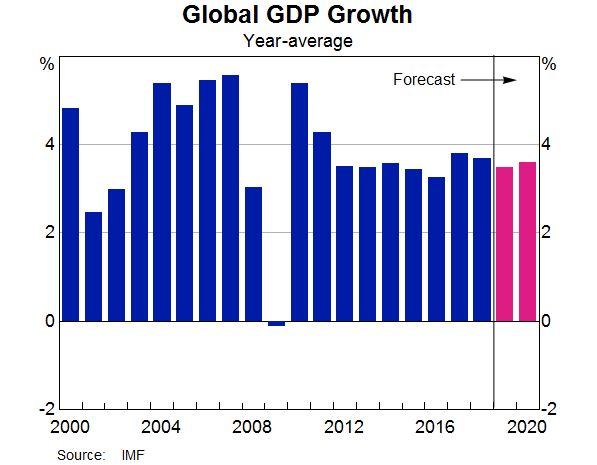
What is of more concern, though, is the accumulation of downside risks. Many of these risks are related to political developments: the trade tensions between the United States and China; the Brexit issue; the rise of populism globally; and the reduced support from the United States for the liberal order that has supported the international system and contributed to a broad-based rise in living standards. One could add to this list the adjustments in China as the authorities rein in shadow financing.
The origins of these diverse issues are complex, but there is a common economic element to some of them: that is, the extended period of little or no growth in real incomes for many people. In a number of countries, growth in real wages has been weak or negative for years. Advances in technology and greater competition as a result of globalisation also mean that many people worry about their own future and that of their children. Politicians, understandably, are responding to these concerns. Time will tell, though, whether the various responses help or not. I suspect that some of them will not.
Over recent months, the accumulation of downside risks has been evident in business and consumer surveys. It was also evident in increased volatility in financial markets around the turn of the year, with declines in equity prices and an increase in credit spreads (Graph 3). Since then, though, markets have been more settled and some of the earlier decline in equity prices has been reversed. This has been partly on the back of a reassessment of the path of monetary policy in the United States, with markets no longer pricing in further increases in US interest rates. There has also been a noticeable fall in long-term government bond yields.
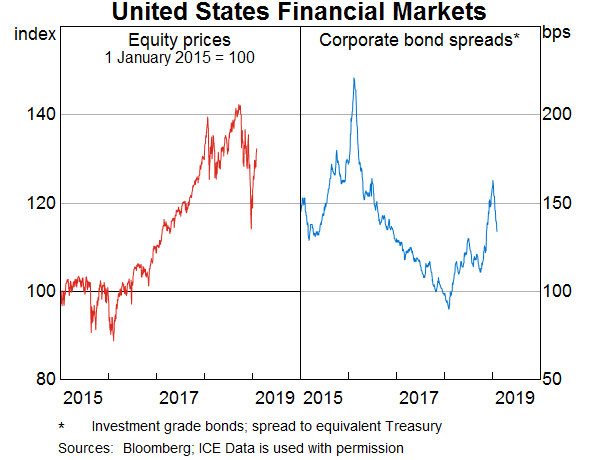
The adjustments in financial markets over our summer sometimes generated reporting that, to me, seemed overly excitable. I lost count of how many times I read the words ‘crash’, ‘plunge’ and ‘dive’. Yet there is a positive side to some of these adjustments, which gets less reported on. The risks associated with stretched valuations in some equity markets have lessened. So, too, have concerns that very low credit spreads could lead to an excessive build-up of risk. And risks in many emerging market economies have also receded, helped by the lower global interest rates and lower oil prices. So it is important to look at the whole picture.
For Australia, what happens in China is especially important. Growth there has slowed. From a medium-term perspective, this has a positive side, as it mainly reflects efforts to rein in risky financial practices and stabilise debt levels. But the slowing is probably faster than the government had hoped for, with the economy feeling the effects of the trade dispute with the United States and the squeezing of finance to the private sector. The authorities have responded by easing policy in some areas, but they are walking a fine line between supporting the economy and addressing the debt problem. There is also the question of how the economy responds to the policy easing.
More broadly, we cannot insulate ourselves completely from the global risks, but keeping our house in order can go a long way to assist. Our floating exchange rate and the flexibility we have on both monetary and fiscal policies provide us with a degree of insulation. So, too, does our flexible labour market. Ensuring that we have predictable and consistent economic policies, credible public institutions and a reform agenda that supports a strong economy can also help in an uncertain world.
The Domestic Outlook
I would now like to turn to the outlook for the Australian economy. Much as is the case globally, the downside risks have increased, although we still expect the Australian economy to grow at a reasonable pace over the next couple of years.
The Australian economy is benefiting from strong growth in infrastructure investment and an upswing in other areas of investment. The labour market is also strong, with many people finding jobs. This year, we will also benefit from a further boost to liquefied natural gas (LNG) exports. The lower exchange rate and a lift in some commodity prices are also assisting. Against this generally positive picture, the major domestic uncertainty is the strength of consumption and the housing market.
We will be releasing a full updated set of forecasts in the Statement on Monetary Policy (SMP) on Friday. Close readers of the SMP will notice that we will now be publishing forecasts for a wider set of variables than has previously been the case.[1] We hope that this helps people understand the various forces shaping the economy.
Today, I can give you a summary of the key numbers.
Our central forecast is for the Australian economy to expand by around 3 per cent over 2019 and 2¾ per cent over 2020 (Graph 4). For 2018, the outcome is expected to be a bit below 3 per cent. This type of growth should be sufficient to see further gradual progress in lowering unemployment.
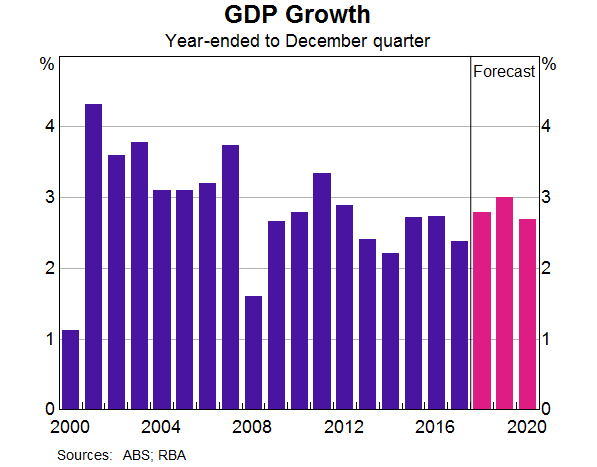
These forecasts are lower than the ones we published three months ago. For 2018, the outcome is affected by the surprisingly soft GDP number in the September quarter and the ABS's downward revisions to estimates of growth earlier in the year. We are expecting a stronger GDP outcome in the December quarter, with other indicators of economic activity painting a stronger picture than suggested by the September quarter national accounts.
For 2019 and 2020, the forecasts have been revised down by around ¼ percentage point, largely reflecting a modest downgrading of the outlook for household consumption and residential construction. I will talk more about this in a moment.
The outlook for the labour market remains positive. The national unemployment rate currently stands at 5 per cent, the lowest in over seven years (Graph 5). In New South Wales and Victoria, the unemployment rate is around 4¼ per cent. You have to go back to the early 1970s to see sustained lower rates of unemployment in these two states. The forward-looking indicators of the labour market also remain positive. The number of job vacancies is at a record high and firms' hiring intentions remain strong. Our central scenario is that growth will be sufficient to see a modest further decline in unemployment to around 4¾ per cent over the next couple of years.
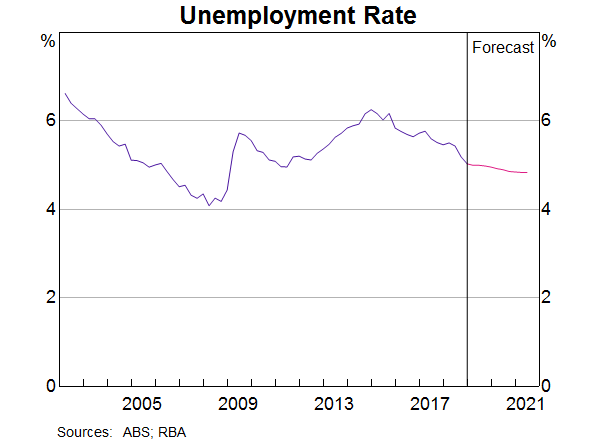
The other important element of the labour market is how fast wages are increasing. For some time, we have been expecting wages growth to pick up, but to do so gradually. The latest data are consistent with this, with a turning point now evident in the wage price index (Graph 6). Through our discussions with business we are also hearing more reports of firms finding it difficult to find workers with the necessary skills. In time, this should lead to larger wage rises. This would be a positive development.
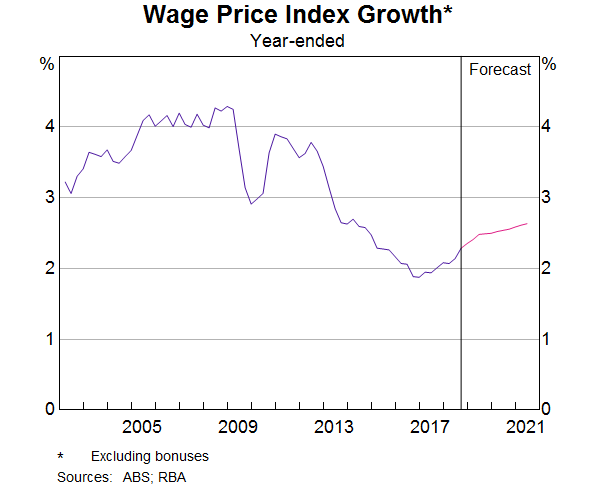
Given this outlook, we continue to expect a gradual pick-up in underlying inflation as spare capacity in the economy diminishes (Graph 7). However, the lower forecast for growth means that this pick-up is expected to occur a bit later than we'd previously thought. Underlying inflation is now expected to increase to about 2 per cent later this year and to reach 2¼ per cent by the end of 2020. The latest CPI data were consistent with this outlook. The headline CPI number was, however, a bit lower than we had previously expected, reflecting the decline in petrol prices that started late last year. We expect headline inflation to decline further this year as the full effect of lower petrol prices shows up in the figures.
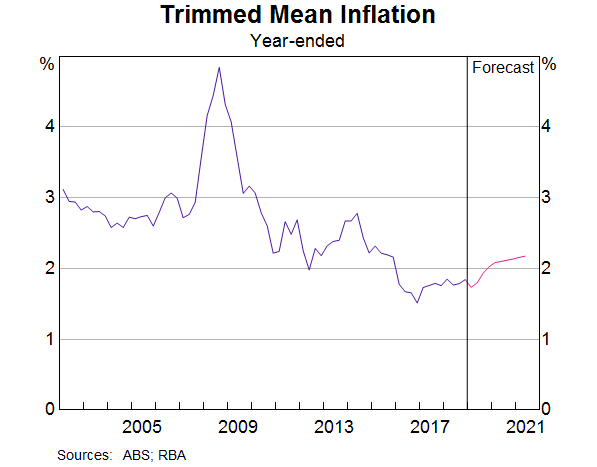
So that is the summary of the key numbers.
As always, there is a range of uncertainties, many of which will be discussed in the SMP on Friday. Today, though, I would like to focus on the outlook for household spending, which is closely linked to the housing market and the prospects for growth in household income.
Before I do that, I would like to touch on one related uncertainty that we have been paying attention to – that is the supply of credit. This is because a strong economy requires access to finance on reasonable terms. Over recent years there has been a needed tightening of credit standards. But the right balance needs to be struck. As lenders have sought to find that balance, we have had some concerns that the pendulum may have swung too far the other way, especially for small business.
In that context, I welcome the report of the Royal Commission and the Government's response. The Commission's recommendations that bear on credit provision are balanced and sensible, and should remove some uncertainty. I also welcome the Commission's focus on: the importance of service – as opposed to sales – in the financial sector; the necessity of dealing properly with conflict of interest issues; and the importance of accountability when things go wrong. These are all issues I have spoken about on previous occasions. Addressing them is central to rebuilding the all-important trust in our financial system.
Housing Prices and Household Income
But back to household consumption and the housing market.
You might recall that 18 months ago, one of the most talked about issues in the country was the high and rising cost of housing. This was understandable. In some of our cities, purchasing a home had become a very difficult stretch for many people, and this had become a major social issue.
Today, the talk is about prices falling in our two largest cities. We have moved almost seamlessly from worrying that prices were going up, to worrying that they are going down.
There is no single reason for this change, but, rather, it is the result of a number of factors coming together.
One is that housing prices simply increased to the point in Sydney and Melbourne where demand tailed off, as purchasing a home had become very expensive and less attractive as an investment.
A second is that the building boom over recent times significantly increased the supply of dwellings. It took a number of years before the rate of home construction picked up in response to faster population growth, but eventually it did pick up. This explains much of the cycle.
A third factor is that the demand from overseas investors softened, partly in response to the Chinese authorities making it more difficult to move money out of China.
And a fourth factor is that lending standards have been tightened and credit has become more difficult to obtain.
Importantly, unlike most other housing price corrections, this one has not been associated with rising unemployment or higher interest rates. Instead, mainly structural factors – relating to the underlying balance of supply and demand – in our largest cities have been at work.
The question is: what effect will this change have on household spending?
Here, my earlier observation about not having a crystal ball is relevant. At this point, though, what we are seeing looks to be a manageable adjustment in the housing market. It is not expected to derail economic growth. The previous trends in debt and housing prices were becoming unsustainable and some correction was appropriate. We recognise that this correction will have an effect on parts of the economy. But our economy should be able to handle this, and it will put the housing market on a more sustainable footing.
There are a few considerations here.
The first is that the recent housing price declines follow very large increases in prices (Graph 8). Even after the recent declines in Sydney, prices are still 75 per cent higher over the decade. In Melbourne, they are 70 per cent higher. While the price falls are no doubt difficult for some, including people who purchased in the past couple of years, there are many people sitting on very significant capital gains and there are others who now will find it easier to purchase a home. And of course, in a number of cities and much of regional Australia, things have been more stable.
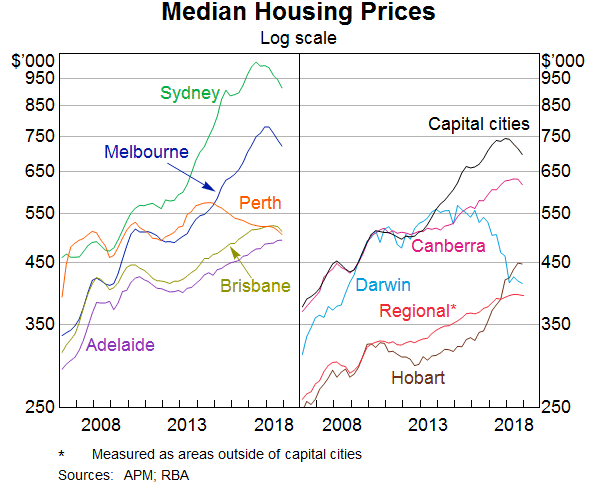
A second consideration is that most households do not change their consumption in response to short-term changes in their wealth. Sensibly, many people tend to take a longer-term perspective. During the recent upswing in housing prices, the strategy of borrowing against the extra equity in your home looked less sensible than it once was, especially as debt levels rose. Some home-owners also see themselves as being part of the ‘bank of mum and dad’. This meant that they refrained from spending the extra equity so that they were able to help their children purchase their own property.
A third and perhaps the most important consideration, is that household income growth is expected to pick up and income growth usually matters more for consumption than changes in wealth.
For some years, growth in nominal aggregate household income has been unusually slow, averaging just 2¾ per cent since 2016 (Graph 9). For some home-owners, rising housing prices have provided an offset to this, even though the effect may have been smaller than in the past. As a result, aggregate consumption has grown faster than income for the past few years. But a shift is now taking place. Over the next year, we are expecting a pick-up in household disposable income to provide a counterweight to the wealth effects of lower housing prices.
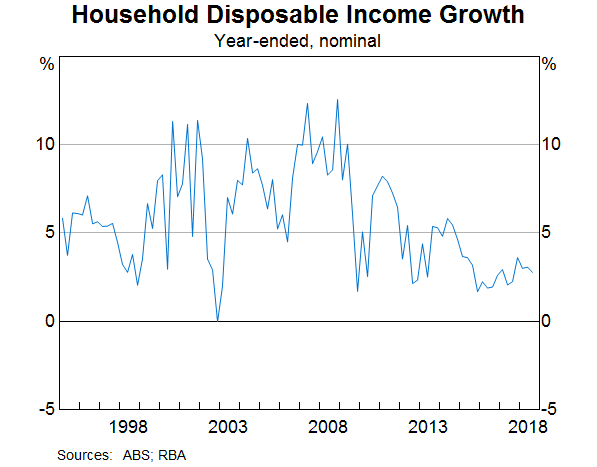
Labour market outcomes are key to this assessment. Continued employment growth and higher wages growth should boost disposable incomes. The announced tax cuts should also help here. In our central scenario, consumption is expected to grow at around 2¾ per cent over the next couple of years, broadly in line with expected growth in disposable income. This is a bit lower than our earlier forecast for consumption.
There are, of course, other possible outcomes. Continued low income growth, together with falling housing prices, would be an unwelcome combination and would make for a softer outlook for the economy. Some Australian households have high levels of debt, so there is a degree of uncertainty about how they would respond to this combination. So we are monitoring things closely.
The adjustment in the housing market is also affecting the economy through residential construction activity and the spending that occurs when people move homes. Residential construction activity is currently around its peak level and the large pipeline of approved projects is expected to support activity for a while. Developers, though, are finding it more difficult to sell apartments off the plan, and lenders are less willing to provide finance. Sales of new detached dwellings have also slowed. The central forecast is for dwelling investment to decline by about 10 per cent over the next two and a half years.
Putting all this together, our economy is going through an adjustment following the turn in the housing markets in our largest cities. It is important that we keep this in perspective though.
The correction in the housing market follows an extended period of strength. It is largely due to structural supply and demand factors, and is occurring against the backdrop of a robust economy and an expected pick-up in income growth. Our financial institutions are also in a strong position to deal with the adjustment. Indeed, lending standards were strengthened as the upswing went on. From this perspective, the adjustment in the housing market is manageable for the financial system and the economy. This adjustment will also help increase the affordability of housing for many people. Even so, given the uncertainties, we are paying very close attention to how things evolve.
Monetary Policy
This brings me to monetary policy.
The cash rate has been held steady at 1½ per cent since August 2016. This setting has helped support the economy. The Reserve Bank Board has sought to be a source of stability and confidence while our economy adjusted to the end of the mining investment boom and responded to the shifting sands of the global economy.
Over the past couple of years, economic conditions have been moving in the right direction. The labour market has strengthened, and the unemployment rate has fallen and a further decline is expected. Inflation is also above its earlier trough, although it has not changed much over the past year. Our expectation has been – and continues to be – that the tighter labour market and reduced spare capacity will see underlying inflation rise further towards the midpoint of the target range. Given this, we have maintained a steady setting of monetary policy while the labour market strengthens and inflation increases.
Looking forward, there are scenarios where the next move in the cash rate is up and other scenarios where it is down. Over the past year, the next-move-is-up scenarios were more likely than the next-move-is-down scenarios. Today, the probabilities appear to be more evenly balanced.
We will be monitoring developments in the labour market closely. If Australians are finding jobs and their wages are rising more quickly, it is reasonable to expect that inflation will rise and that it will be appropriate to lift the cash rate at some point. On the other hand, given the uncertainties, it is possible that the economy is softer than we expect, and that income and consumption growth disappoint. In the event of a sustained increase in the unemployment rate and a lack of further progress towards the inflation objective, lower interest rates might be appropriate at some point. We have the flexibility to do this if needed.
The Board will continue to assess the outlook carefully. It does not see a strong case for a near-term change in the cash rate. We are in the position of being able to maintain the current policy setting while we assess the shifts in the global economy and the strength of household spending.
It has long been the Board's approach to avoid reacting to the high-frequency ebb and flow of news. Instead, we have sought to keep our eye on the medium term and put in place a setting of monetary policy that helps deliver on our objectives of full employment, an inflation rate that averages between 2 and 3 per cent, and financial stability.
Thank you for listening. I look forward to answering your questions.
